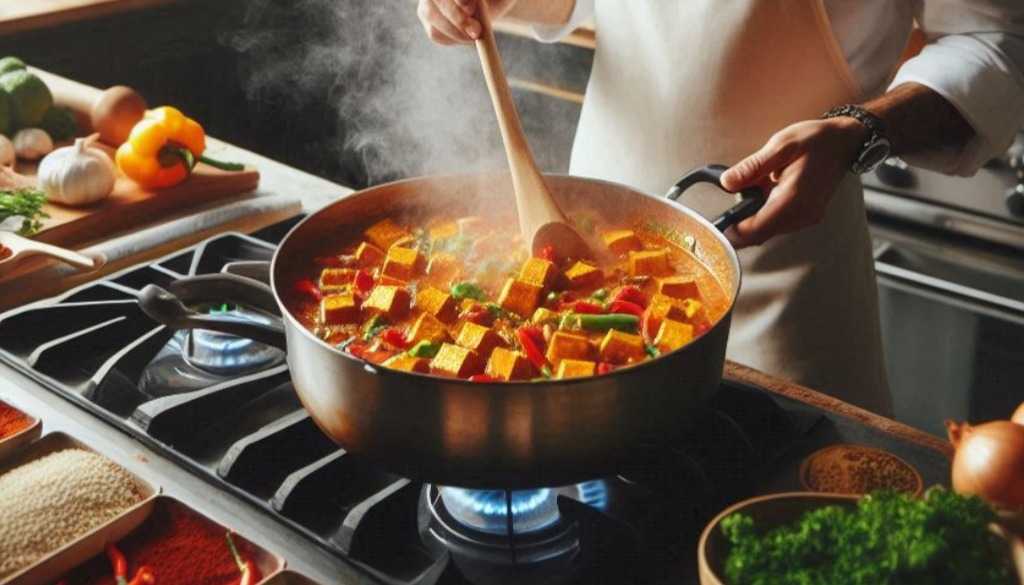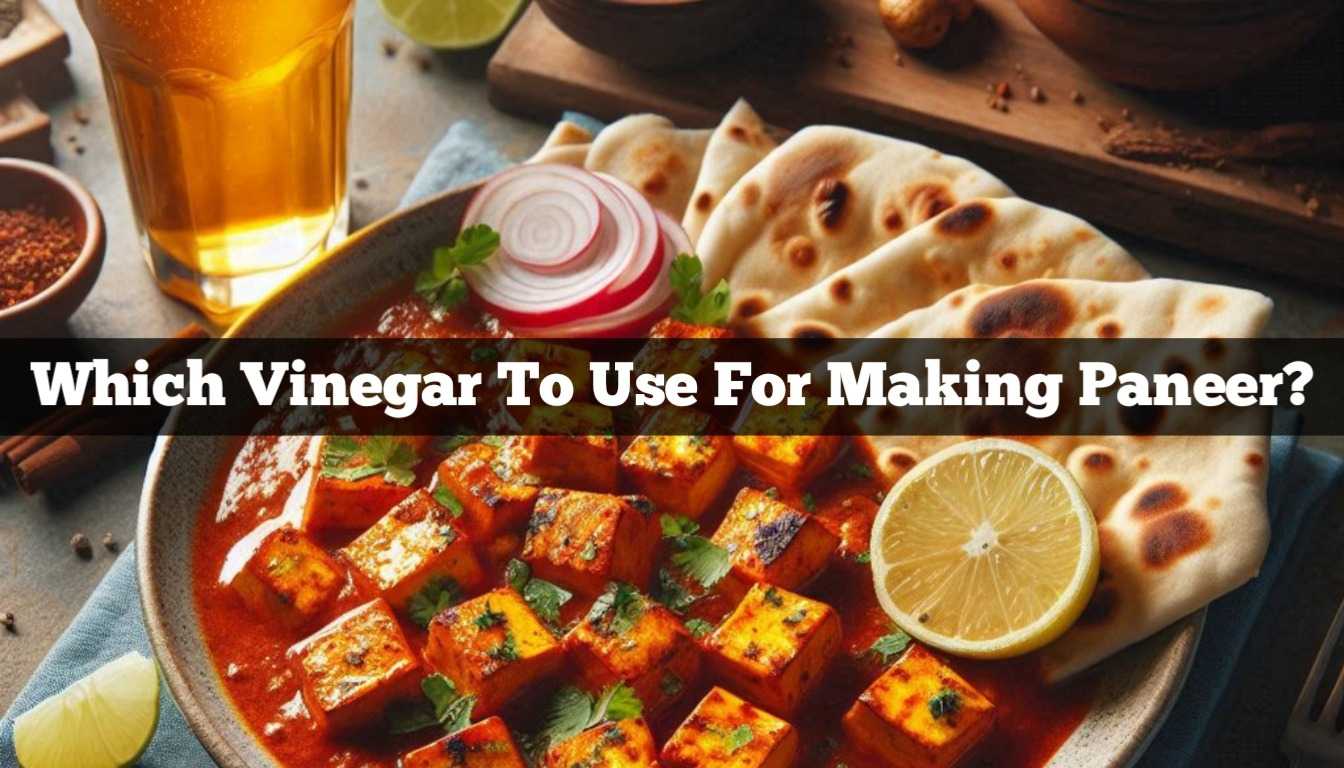Which Vinegar To Use For Making Paneer: Lemon juice is traditionally used to coagulate milk for paneer, many now use vinegar as a reliable and convenient alternative. But with so many types of vinegar available, the question arises:
Which vinegar should be used for making paneer? Let’s explore the options and understand how to use vinegar for best results.
Why Choose Vinegar Over Lemon Juice To Make Paneer?
Vinegar offers several advantages over lemon juice when making paneer. Firstly, it provides a consistent acidity level, which is crucial for coagulating milk effectively. Secondly, vinegar does not leave a strong citrus flavor, keeping paneer neutral and adaptable to any dish. Finally, vinegar is more shelf-stable and often more economical than fresh lemons, making it a convenient option.
How Vinegar Helps in Making Paneer
The process of making paneer involves turning milk into curds by adding an acidic agent. Vinegar, being highly acidic, lowers the pH of the milk, causing the proteins to coagulate and form curds. These curds are then separated from the liquid whey and pressed to form paneer. The acidity present in vinegar ensures a quick and efficient curdling process, resulting in soft and fluffy paneer.

Can We Use Vinegar Instead of Lemons to Make Paneer?
Yes, vinegar is a great substitute for lemon juice in paneer making. It provides the same acidity needed to turn milk into curds, without any sour taste. This makes vinegar especially useful if you plan to use paneer in recipes where neutral flavors are preferred, such as desserts or mildly spiced dishes.
Can We Use White Vinegar To Make Paneer?
Absolutely! White vinegar is one of the most effective options for making paneer. It has a strong acidic nature that curdles milk quickly, and it does not leave any residual taste in the paneer. Its affordable price and availability make it a favorite choice of many home cooks.
Can We Use Apple Cider Vinegar to Make Paneer?
Yes, apple cider vinegar is a viable option for making paneer. Its mild acidity is enough to curdle milk, and the slightly fruity flavor can add a unique flavor to paneer. It can work well in salads or recipes where the apple flavor matches with other ingredients.
Can We Use Synthetic Vinegar to Make Paneer?
Yes, synthetic vinegar can be used to make paneer, although it needs to be handled carefully. Since synthetic vinegar is highly acidic, using it in excess can make the paneer too tart. Make sure you rinse the curds thoroughly to remove any residual flavor.
Can We Use Chilli Vinegar to Make Paneer?
Although chilli vinegar has the required acidity to curdle milk, it is not recommended for making paneer. The pungent and tangy flavor of chilli vinegar can overpower the neutral flavor of paneer, making it unsuitable for most recipes.
Which Vinegar to Use for Making Paneer?
Different types of vinegar can be used to make paneer, each with its own distinct properties. Here is a detailed look at the most commonly used varieties:
1. White Vinegar
White vinegar is the best choice for making paneer, as it has strong acidity and neutral flavor. It curdles milk quickly and does not leave any aftertaste, making it ideal for traditional paneer recipes.
How to use:
- Bring 1 liter of full-fat milk to a boil.
- Reduce the heat and add 1-2 tablespoons of white vinegar diluted in water.
- Stir gently until the milk curdles, then strain and press.
2. Apple Cider Vinegar
Apple cider vinegar is another good option, especially if you like a natural and slightly fruity taste. Though it has a milder acidity than white vinegar, it is still effective for curdling milk.
How to use:
- Use about 3 tablespoons of apple cider vinegar for 1 liter of milk.
- Dissolve it in water and then add it so that the curds set well.
3. Synthetic Vinegar
Synthetic vinegar is an economical option that is easily available. However, it may leave a slightly pungent or chemical taste in the paneer, which can be reduced by rinsing the curds thoroughly after straining.
4. Chilli Vinegar
Chilli vinegar is not ideal for making paneer. Its pungent and sharp flavor can overpower the flavor of paneer, making it less useful for traditional recipes.

Table: Types of Vinegar for Cheese
| Type of Vinegar | Acidity | Flavor Impact | Best For |
|---|---|---|---|
| White Vinegar | Strong | Neutral | All types of dishes |
| Apple Cider Vinegar | Moderate | Slightly fruity | Salads, desserts |
| Synthetic Vinegar | Strong | Sharp, chemical taste | Budget-friendly options |
| Chilli Vinegar | Moderate | Spicy, tangy | Not recommended for paneer |
Step-By-Step Guide to Making Paneer With Vinegar
Here is a simple guide to making soft and flavourful paneer using vinegar:
1. Heat the Milk
Add 1 liter of full-fat milk to a heavy-bottomed pan. Heat it on medium flame, stirring occasionally to prevent burning.
2. Add Vinegar
When the milk starts boiling, reduce the heat. Add 1-2 tablespoons of vinegar (dissolved in water) while slowly stirring.
3. Curdling Process
Keep stirring till the milk curdles completely and the whey separates. If it does not curdle, add a little more vinegar.
4. Strain the Curds
Place a muslin cloth or a clean kitchen towel in a colander. Pour the curdled milk into the strainer to separate the curds from the buttermilk.
5. Rinse the Curds
Rinse the curds under cold running water to remove any remaining vinegar and refrigerate.
6. Shape the Paneer
Gather the edges of the cloth, fold it tightly and press the curds to form a block. Place a heavy object on top to set the paneer for 1-2 hours.
Tips for Perfect Paneer
- Always use fresh, full-fat milk for best results.
- Avoid boiling the milk after adding vinegar, as this can make the paneer hard.
- Use a muslin cloth to strain the curds, as this improves the texture of the curds.
- Rinse the curds thoroughly to remove any acidic taste.
Conclusion
So, here we have discussed the topic “Which Vinegar To Use For Making Paneer?” I hope you’ve learned something new from this post and if you liked it, make sure to share it on any of your social media platforms.
Frequently Asked Questions
-
Can expired vinegar be used for cheese?
It is not advisable to use expired vinegar. Over time, the acidity of vinegar decreases, which can affect the curdling process. Always check the expiry date and make sure the vinegar is fresh for best results.
-
Why is my cheese crumbly?
If the milk does not coagulate properly or the curds are not pressed evenly, the cheese may turn crumbly. Make sure the milk is completely curdled before straining and press the paneer gently to retain its structure.
-
Can I reuse the whey after making paneer?
Yes, whey is rich in nutrients and can be used in place of water in soups, curries, or dough. It is a great way to reduce wastage and add nutrition to your meals.
-
How long can homemade paneer be stored?
Homemade paneer can be stored in the refrigerator for 2-3 days in an airtight container submerged in water. For longer storage, freeze the paneer in an airtight bag.
-
Can I add flavors while making paneer?
Yes! You can add herbs, spices, or even garlic to the milk during the curdling process to make flavourful paneer. This works well for special recipes where you want to enhance the flavor.


4 thoughts on “Which Vinegar To Use For Making Paneer?”